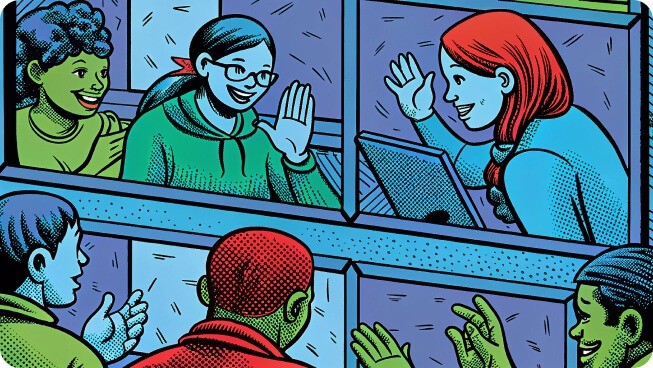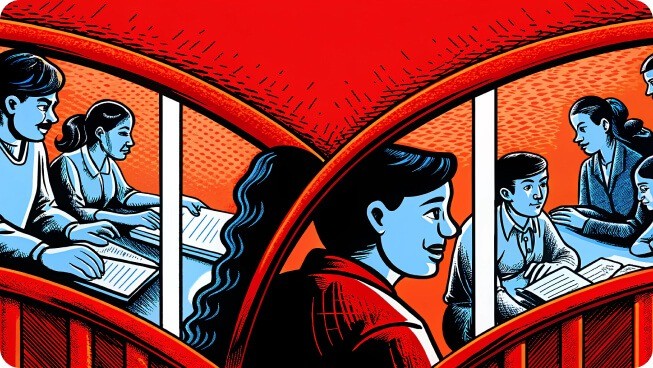The classic language practice tasks are the solo tasks with limited actual interaction. But language prospers on dialogue and common problem-solving. By replacing assignments and grades with collaborative group lessons in your Learning Management System (LMS), you can get learners to talk, think, and build together. This guide provides simple, clear, and practical steps for designing group lessons, ensuring that students stay engaged, and managing them without any issues, even with all-online classes.
Goals and Grouping
Clarity is the beginning of a successful group lesson.
-
Identify a single key skill cycle. For example, improve speaking fluency, or practice the past tense in conversation.
-
Make groups small and equal. Four to eight learners of equal CEFR level (e.g., B1B2) are the most effective.
-
Set concrete outcomes. Rather than talk more, use such instructions as each student speaks for at least 3 minutes per session or the team writes a 200-word summary.
-
Stabilize groups. Retain the same members for 4-6 weeks, and trust develops.
-
Rotate roles. Share the responsibility of assigning the role of a facilitator, timekeeper, note-taker, and reporter.
Clear grouping would prevent confusion, and every person would understand the reason to collaborate.
Workflow Design
An easy, repetitive pattern helps you keep group lessons ordered. To this end, apply a three-phase loop. First, the learners should prepare: watch a video, review vocabulary, or answer warm-up questions. Then, they proceed to the live session, where they can meet each other, practice, and collaborate. Then, request students to provide a collaborative product, reflection, or peer review.
Build this loop into your LMS. Create a Sprint module with weekly sections and checklists. Release content automatically on completion of pre-tasks. Calendar events and prompts ensure no one misses deadlines.
This is a predictable workflow that allows students to keep on track and saves teacher administration. No one is unaware of what precedes, occurs, and follows every session.
Collaborative Task Design
Group language learning is most effectively done when students are challenged to talk and create something with each other. Task-based learning is the most appropriate: The students exchange information they do not have, summarize some part of a text or audio, play or argue some role, or create a mini-project such as a video or a slide.
It should always have a definite result (e.g., a collaborative document, a brief audio, or a discussion board post). Give structure by describing the purpose, allocating roles, time limits, and indicating where the students are expected to submit. Give them sentence beginnings, important words, or pictures.
Properly organized activities ensure that the communication is meaningful and can be managed during the classroom lessons and on the LMS.
Live Session Playbook
The interactive live lesson will make students talk.
-
Introduce a 5-minute warming-up: quick poll, word association, one-sentence check-in.
-
Conduct the primary activity (20 minutes): divide the learners into breakout rooms or small groups. Write down instructions after the lesson.
-
Report back (10 minutes): the reporters of each group present some critical points.
-
Feedback and wrap-up (5 minutes): mention positive language use, explain errors, and establish follow-up.
This is a predictable format where sessions are less chaotic and everyone is held together.
Asynchronous Collaboration
Excellent group work does not end when the video call is over. Maintain continuity between sessions with some easy, structured tasks.
-
Forum questions: have learners write summaries, new words, or a question.
-
Voice threads: ask them to use short responses but not write them.
-
Peer comments: specific protocols, such as SBI (Situation–Behavior–Impact), would help you ensure the comments remain specific.
-
Micro-challenges: one-sentence stories, mini-quizzes, or hunts to find an example online.
-
Pair work: students review the drafts of other students or practice a conversation asynchronously.
Program automated schedule notifications, time-out deadline prompts, and grace periods on late work within your LMS. Promote short-term and occasional interaction in place of long-term and tension-filled tasks.
These steps make a partnership feel organic and ongoing, not merely an occurrence that takes place during live instruction.
Assessment That Rewards Teamwork
To maintain the drive in a group, it is good to monitor not only the fact that their language levels are improving but also the effectiveness with which they collaborate. One of these is by having a simple two-part rubric: the first part examines language, accuracy, fluency, and vocabulary, and the second examines collaboration, including how much students contribute, answer their peers, and support members.

Integrate the various facets of assessment. Student self-assessment and peer review help to keep the student engaged and reflective on teacher feedback. With the majority of LMS platforms, scoring or commenting on all people is easy.
Concentrate on the learning process rather than the end outcome. Monitor attendance, view the contribution of each student by specific documents, or the number of times one responds to classmates. Continue grading slowly and steadily; little points per week are better than one large examination.
It is also useful to demonstrate the rubric to the students as early as possible. Once they realize that teamwork is as essential as talking perfectly, they will tend to help others and still enhance their language skills. Such a moderate approach ensures that all remain busy, accountable, and motivated to develop.
Supporting Diverse Learners
Not all students talk easily. Your LMS will even the playing field.
-
Scaffold language: provide sentence beginnings, phrase books, and sample responses.
-
Prep time: allow nervous students to practice by taking notes or making a draft to speak.
-
Provide several platforms: chat, voice notes, and shared docs are considered as involvement.
-
Establish fair-take regulations: talking sticks, timers, or round-robin check-ins.
-
Prepare to fight: negotiate the use of civil language, issue a simple pause, and refer to the teacher's rule.
The steps ensure introverted and mixed-level group lessons are safe and suitable for different learners’ needs.
Motivation and Gamification
Grades are not enough to keep groups engaged in the long term. Appreciation is one method of creating motivation. You may give digital badges for frequent attendance, helpful feedback, or project completion. Emphasize improvement by demonstrating the number of weeks a team has achieved its objectives consecutively.
As well, you can promote healthy competition by displaying group progress on a leaderboard with points assigned for completed tasks or participation. Achievement celebrations are also good in public, such as showing the finest group outputs on a wall titled wins in the LMS. To complete a learning cycle, conduct a brief presentation session or post an e-book with all the group work.
The greatest strength of gamification is its behavioral basis: collaboration, encouragement, and consistent practices, rather than perfect grammar or flawless performance.
Privacy and Safety
Secrecy is important to learners, particularly when lessons are recorded or published.
-
Establish good camera and recording guidelines: seek permission and archive files.
-
Post a code of conduct: describe how to be respectful in communication and reporting.
-
Compliant with the local regulations: ensure GDPR or other privacy regulations if you teach minors or students from the EU.
Security develops confidence and engagement.
Tech Stack and Integrations
Have reliable and straightforward tools.
-
LMS essentials: use provided groups, rubrics, calendars, forums, and group assignments.
-
Video conferencing: Zoom, Meet, or native LMS video rooms to practice live.
-
Teamwork tools: collaborative files, presentations, or whiteboards.
-
Captions and transcripts: assist learners in tracking discussions and reviewing them.
Choose only one primary home base, which is your LMS, and only incorporate extras when they will really be helpful. Fewer tools imply reduced confusion, simplified onboarding, and fewer technical problems during classes.
30-Day Launch Plan
A well-organized roll-out can help you avoid overwhelming students and yourself. Splitting the process into weekly steps, you can easily organize group lessons and manage them as you move on.
Week 1 – Plan and Prepare
Begin by explaining the target learning outcome of your group lessons and selecting the kind of activity you will be doing. Prepare a two-part rubric, which is language and collaboration-based. Set up one “Sprint” module in your LMS with clear sections for pre-lesson, live session, and post-lesson work. Prepare for the first session by onboarding students: clarify what they are to do, demonstrate the workflow, and explain the expectations.
Week 2 – Pilot a Small Group
Test your plan by conducting a single small-group lesson. Then, get fast feedback: did the technology work well, and were the instructions understandable? Apply what you observe to change the time, task design, or rubric.

Week 3 – Scale Up
After the pilot is running successfully, start all the groups with a better structure. Include peer review assignments and discussion forums to facilitate asynchronous learning. Send notifications and encouragement impulses to maintain student attention.
Week 4 – Showcase and Reflect
Conclude the sprint with a brief presentation session or post the group deliverables. Then, conduct a simple survey to determine what worked well and what needs improvement. Feedback on these insights to make changes to your following cycle: update tasks, improve the rubric, or improve your LMS.
Conclusion
Leaving individual homework to actual collaboration transforms language learning. Groups can discuss, create, and enhance with established objectives, systematic tasks, and straightforward LMS tools. Begin small, follow the 30-day plan, and optimize each cycle. Very soon, your classes will not be so lonely drills but actual teamwork, where language is alive.




